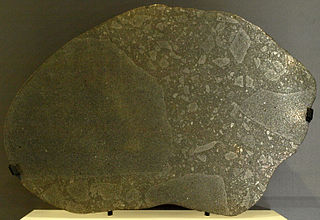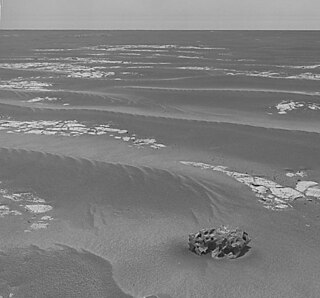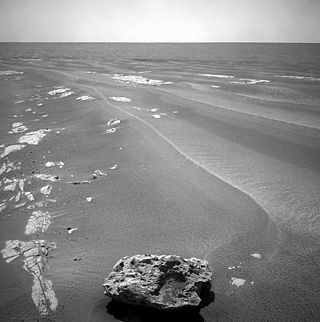Related Research Articles

A meteorite is a solid piece of debris from an object, such as a comet, asteroid, or meteoroid, that originates in outer space and survives its passage through the atmosphere to reach the surface of a planet or moon. When the original object enters the atmosphere, various factors such as friction, pressure, and chemical interactions with the atmospheric gases cause it to heat up and radiate energy. It then becomes a meteor and forms a fireball, also known as a shooting star; astronomers call the brightest examples "bolides". Once it settles on the larger body's surface, the meteor becomes a meteorite. Meteorites vary greatly in size. For geologists, a bolide is a meteorite large enough to create an impact crater.

A chondrule is a round grain found in a chondrite. Chondrules form as molten or partially molten droplets in space before being accreted to their parent asteroids. Because chondrites represent one of the oldest solid materials within the Solar System and are believed to be the building blocks of the planetary system, it follows that an understanding of the formation of chondrules is important to understand the initial development of the planetary system.

Annaheim is a village in the Canadian province of Saskatchewan within the Rural Municipality of St. Peter No. 369 and Census Division No. 15. The village is located about 125 km east of the City of Saskatoon, at the junction of provincial Highway 756 and Highway 779. Annaheim hosts the offices of the Rural Municipality of St. Peter No. 369.
Annaheim may refer to:

Iron meteorites, also called siderites or ferrous meteorites, are a type of meteorite that consist overwhelmingly of an iron–nickel alloy known as meteoric iron that usually consists of two mineral phases: kamacite and taenite. Most iron meteorites originate from cores of planetesimals, with the exception of the IIE iron meteorite group

The Fukang meteorite is a meteorite that was found in the mountains near Fukang, China in 2000. It is a pallasite—a type of stony–iron meteorite with olivine crystals. It is estimated to be 4.5 billion years old.

Pallasovka is a pallasite meteorite found in 1990 near the town of Pallasovka, Russia.

Enstatite chondrites are a rare form of meteorite, rich in the mineral enstatite. Only about 200 E-Type chondrites are currently known, comprising about 2% of the chondrites that fall on Earth. There are two main subtypes: EH and EL, classified based on their iron content.
Chambord is an iron meteorite found in Quebec.
St-Robert is an ordinary chondrite meteorite fell on Quebec on June 14, 1994.
Penouille is an iron meteorite found in 1984 in Canada.
Lac Dodon is an iron meteorite discovered by Roland Octerneau of Montreal on rural private property near Lac Dodon, Saint-Calixte, Quebec.

Elbogen, also the Loket Iron, is an iron meteorite that fell in the village of Loket, Karlovy Vary Region, Kingdom of Bohemia, about the year 1400. Also known during the Middle Ages as the "bewitched burgrave" of Elbogen, due to a cursed Count at the Elbogen castle, it is the oldest of 15 recorded falls in the Czech Republic. It has not survived to our time in its original size, having been cut for scientific purposes and its pieces sent to museums all around the world.
The Blithfield meteorite was found by Joseph Legree in Blithfield Township, Renfrew County, Ontario and measured about 8 centimetres (3.1 in) x 10 centimetres (3.9 in) x 13.5 centimetres (5.3 in). The main mass is now in the Canadian National collection, Ottawa. Blithfield is an enstatite chondrite, a group of very unusual meteorites that were formed in a very reducing atmosphere. It is a breccia, one of only five known enstatite chondrite breccias.
Osseo is an iron meteorite found in 1931 by Mr. Frank Johnston about 5 kilometres (3.1 mi) from Osseo, Ontario. It was about 30 centimetres (12 in) long. No fireball was observed and there was no evidence that it was a recent fall.
Gay Gulch is an iron meteorite found in 1901 by miners near Dawson City, Yukon Territory, using a slice box to mine alluvial gold. They were exploiting Pliocene gravel, hence the meteorite may have fallen at that time.

Acapulcoites are a group of the primitive achondrite class of stony meteorites.
This is a glossary of terms used in meteoritics, the science of meteorites.

Shelter Island meteorite was found on Mars by the Opportunity rover on October 1, 2009. It is about 27 centimetres (11 in) long.

Block Island meteorite, officially named Meridiani Planum 006 shortened as MP 006, was found on Mars by the Opportunity rover on July 17, 2009. It is about 67 centimetres (26 in) across.
References
- 1 2 3 Meteoritical Bulletin Database
- ↑ White, R., Canadian Meteorites: a catalogue of meteorites found in Canada. Provincial Museum of Alberta, Edmonton. 1984
- ↑ R.A.A. Johnston, and H.V. Ellsworth, "The Annaheim Meteorite", Transactions of the Royal Society of Canada, Section IV, 1921
- 1 2 Shaw, Andrew M. (2007-01-11). Astrochemistry: From Astronomy to Astrobiology. John Wiley & Sons. ISBN 978-0-470-09138-8.